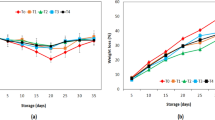Abstract
Turkish noodles (erişte) were substituted with green lentil (Lens culinaris), red lentil (L. culinaris), faba bean (Vicia faba), and pea (Pisum sativum) hulls at the level of 2.5, 5, and 10% and the effects of the substitution on proximate composition, mineral composition, colour, cooking properties, thiamine and riboflavin contents, texture and sensory properties of the noodles were investigated. Crude ash, dietary fibre, Ca and Mg contents of the noodles significantly increased with pulse hull substitution regardless of the hull type compared to control. Lightness or brightness (L*) values of the noodles showed a general decreasing trend with increasing pulse hull substitution excluding pea hull. L* value of the pea hull substituted noodles was higher than that of the control. Water absorption and swelling volume of the noodles remarkably increased with pea hull substitution. Thiamine and riboflavin contents of the control noodles and the noodles substituted with the noted hull types up to 10% were very close to each other. Noodles substituted with faba bean hull at the level of 10% showed the highest hardness, gumminess, and chewiness values. Pea hull substitution up to 10% did not significantly affected the sensory (appearance, texture and overall acceptability) scores of the panellists.
Similar content being viewed by others
References
AACC (2000) Approved methods of American association of cereal chemists, 10th edn. American Association of Cereal Chemists Inc., Minnesota
AOAC (2000) Official methods of analysis, 17th edn. Association of Official Analytical Chemists Inc., Maryland
Chillo S, Monro JA, Mishra S, Henry CJ (2010) Effect of incorporating legume flour into semolina spaghetti on its cooking quality and glycaemic impact measured in vitro. Int J Food Sci Nutr 61:149–160
Chitra U, Singh U, Rao PV (1996) Phytic acid, in vitro protein digestibility, dietary fiber and minerals of pulses as influenced by processing methods. Plant Food Hum Nutr 49:307–316
Chung HJ, Cho A, Lim ST (2012) Effect of heat-moisture treatment for utilization of germinated brown rice in wheat noodle. LWT Food Sci Technol 47:342–347
Demi B, Bilgiç N, Elgün A, Demi MK (2010) Effects of chickpea flours and whole egg on selected properties of erişte, Turkish noodle. Food Sci Technol Res 16:557–564
Gulia N, Dhaka V, Khatkar BS (2014) Instant noodles: processing, quality, and nutritional aspects. Crit Rev Food Sci 54:1386–1399
Kanatt SR, Arjun K, Sharma A (2011) Antioxidant and antimicrobial activity of legume hulls. Food Res Int 44:3182–3187
Kaur G, Sharma S, Nagi HPS, Dar BN (2012) Functional properties of pasta substituted with variable cereal brans. J Food Sci Technol 49:467–474
Lee SY, Woo KS, Lim JK, Kim HI, Lim ST (2005) Effect of processing variables on texture of sweet potato starch noodles prepared in a nonfreezing process. Cereal Chem 82:475–478
Liu L, Herald TJ, Wang D, Wilson JD, Bean SR, Aramouni FM (2012) Characterization of sorghum grain and evaluation of sorghum flour in a Chinese egg noodle system. J Cereal Sci 55:31–36
Marconi E, Carcea M (2001) Pasta from non-traditional materials. Cereal Food World 46:522–530
Martín-Cabrejas MA, Aguilera Y, Pedrosa MM, Cuadrado C, Hernández T, Díaz S, Esteban RM (2009) The impact of dehydration process on antinutrients and protein digestibility of some legume flours. Food Chem 114:1063–1068
Masi P, Cavella S, Piazza L (2001) An interpretation of the rheological behavior of wheat flour dough based on fundamental tests. In: Chinachoti P, Vodovotz Y (eds) Bread staling. CRC Press, Boca Raton, pp 75–89
Meilgaard M, Civille GV, Carr BT (1999) Sensory evaluation techniques. CRC Press, Boca Raton
Oomah BD, Patras A, Rawson A, Singh N (2011) Chemistry of pulses. In: Tiwari BK, Gowen A, McKenna B (eds) Pulse foods: processing, quality and nutraceutical applications. Academic Press, London, pp 29–30
Prodanov M, Sierra I, Vidal-Valverde C (2004) Influence of soaking and cooking on the thiamin, riboflavin and niacin contents of legumes. Food Chem 84:271–277
Ramulu P, Rao PU (1997) Effect of processing on dietary fiber content of cereals and pulses. Plant Food Hum Nutr 50:249–257
Singh N (2017) Pulses: an overview. J Food Sci Technol 54:853–857
Singh B, Singh JP, Shevkani K, Singh N, Kaur A (2017) Bioactive constituents in pulses and their health benefits. J Food Sci Technol 54:858–870
Song X, Zhu W, Pei Y, Ai Z, Chen J (2013) Effects of wheat bran with different colors on the qualities of dry noodles. J Cereal Sci 58:400–407
Tiwari BK, Singh N (2012) Pulse chemistry and technology. Royal Society of Chemistry, Cambridge
Tiwari BK, Gowen A, McKenna B (2011) Introduction. In: Tiwari BK, Gowen A, McKenna B (eds) Pulse foods: processing, quality and nutraceutical applications. Academic Press, London, pp 1–5
Tosh SM, Yada S (2010) Dietary fibres in pulse seeds and fractions: characterization, functional attributes, and applications. Food Res Int 43:450–460
Tuncel NB, Yılmaz N, Kocabıyık H, Uygur A (2014) The effect of infrared stabilized rice bran substitution on B vitamins, minerals and phytic acid content of pan breads: part II. J Cereal Sci 59:162–166
Yılmaz Tuncel N, Kaya E, Karaman M (2017) Rice bran substituted Turkish noodles (erişte): textural, sensorial, and nutritional properties. Cereal Chem 94:903–908
Funding
Thanks to the Turkish Scientific and Technological Research Council (TUBITAK) for supporting this research (Project No.: 213O095) and for the scholarship granted to Esra Kaya.
Author information
Authors and Affiliations
Corresponding author
Ethics declarations
Conflict of interest
The authors declare that they have no conflict of interest.
Rights and permissions
About this article
Cite this article
Kaya, E., Yılmaz Tuncel, N. & Tuncel, N.B. Utilization of lentil, pea, and faba bean hulls in Turkish noodle production. J Food Sci Technol 55, 1734–1745 (2018). https://doi.org/10.1007/s13197-018-3086-1
Revised:
Accepted:
Published:
Issue Date:
DOI: https://doi.org/10.1007/s13197-018-3086-1




